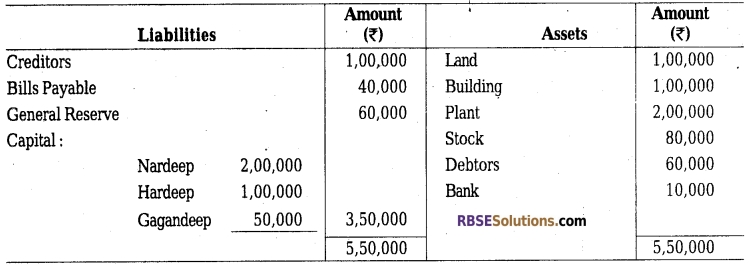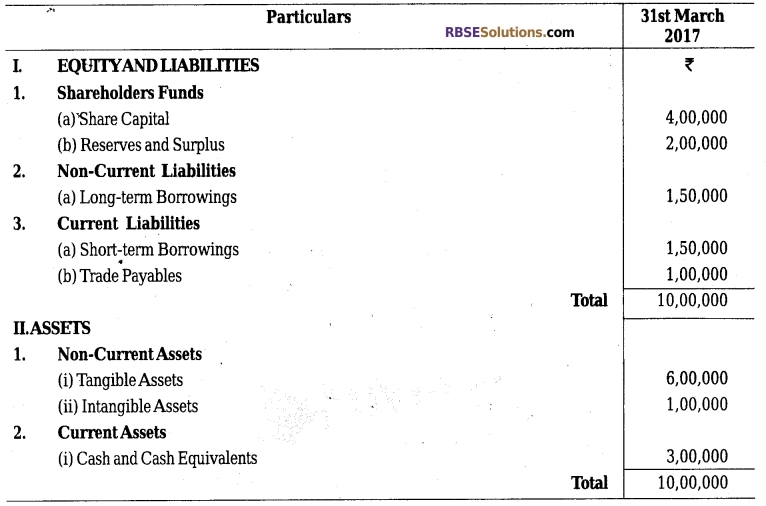RBSE Class 12 Accountancy Model Paper 3 English Medium are part of RBSE Class 12 Accountancy Board Model Papers. Here we have given RBSE Class 12 Accountancy Sample Paper 3 English Medium.
| Board | RBSE |
| Textbook | SIERT, Rajasthan |
| Class | Class 12 |
| Subject | Accountancy |
| Paper Set | Model Paper 3 |
| Category | RBSE Model Papers |
RBSE Class 12 Accountancy Sample Paper 3 English Medium
Time: 3.15 Hours
Maximum Marks: 80
General Instructions to the Examinees
- Candidate must write his/her Roll No. on the question paper compulsorily.
- All the questions are compulsory.
- Write the answer to each question in the given answer book only.
- The questions that have internal sections, write their answers together in continuity.
- I. The questions are divided into two sections- A and B.
II. Section A is compulsory for all.
III. Section B has two parts, and each part has seven questions. Candidate has to answer all the seven questions of either of the part. -
Section Question no Marks per Questions A 1-8 1 9-14 2 15-21 4 22-33 6 B 24-25 1 26-27 2 28-29 4 30 6 - Question number 22 (Section A) and 30 (Section B) have internal choices.
Section – A
Question 1.
What is the minimum limit on number of members in a firm? [1]
Question 2.
When can a partner retire from the company? [1]
Question 3.
At where surrender value statement, of Joint Life Insurance Policy is shown? [1]
![]()
Question 4.
A, B & C are partners in a firm sharing profits in the ratio of 4:3:1. B retires, selling his share of profit to A & C for ₹8,100, ₹ 3,600 being paid by A and ₹ 4,500 by C. Calculate the New Profit Sharing Ratio and Gaining ratio. [1]
Question 5.
What do you understand by disintegration by agreement? [1]
Question 6.
Clarify the meaning of registered capital. [1]
Question 7.
What is the minimum limit on number of members in a Joint Venture? [1]
Question 8.
State the types of securities from the perspective of security. [1]
Question 9.
A and B are partners in a firm, sharing profits in the ratio of 3:2. C is admitted for 1 /4th share in profits of the firm which he acquires from A & B in the ratio of 2:1. Calculate the New Profit Sharing Ratio. [2]
Question 10.
State two differences between joint venture and partnership. [2]
Question 11.
State the difference between revised commission and overriding commission. [2]
![]()
Question 12.
If consignee is not entitled for Delcredere commission and? 1500 due to debtors become bad, What entry will be passed in the books of the consigner for such bad debts? [2]
Question 13.
Name any two items that are not shown in the Receipts and Payment Account. [2]
Question 14.
From the following information, calculate Opening Capital funds as on 1 Jan. 2017. Building ₹ 1,20,000, Furniture ₹ 24,000, Cash in hand (1.1.2017) ₹ 18,700, Fixed Deposits (1.1.2017) ₹ 20,500, Outstanding Subscription for 1 Jan. 2017 ₹ 9,700; Outstanding salary ₹ 6,700, Subscription Received in Advance for 1 Jan. 2017 ₹ 6,200, Creditors for Sports material as on 1 Jan. 2017 ₹ 5,000 [2]
Question 15.
X, Y and Z are partners sharing profit in ratio 5:3:2. Z gives a guarantee to firm of minimum ₹ 1,20,000 earnings but Z could earn only ₹ 80,000 for the firm. Total profit earned by the firm is ₹ 2,00,000. Prepare Profit & Loss Appropriation Account for distribution of profit among partners. [4]
Question 16.
A, B and C are partners in a firm whose books are closed on March 31 st each year. A died on 30.6.17, and according to the agreement, the share of profits of a deceased partner up to the date of death is to be calculated on the basis of the average profits for the last five years. The net profit/loss for the last 5 years has been: ₹ 14,000, ₹ 18,000, ₹ 22,000, ₹ (10,000) Loss, ₹ 16,000 respectively. Calculate A’s share of the profits up to the date of death and pass necessary Journal Entry. [4]
Question 17.
Explain the rules of Gamer v/s Mueray. [4]
![]()
Question 18.
Under what headings will you show the following items in the Balance Sheet of the Company: [4]
Goodwill
Provision for Tax
Unclaimed Dividends
Loose Tools
Securities Premium
Question 19.
Explain in brief the methods accounting of joint venture. [4]
Question 20.
Mr Harish of Mumbai consigned 20 items to Chain Singh of Jaipur at ₹ 1,800 per item at cost. He spent ₹ 2,000 on consignment. On the way, 4 items are destroyed. Insurance Co. accepted 80% claim. Consignee sold destroyed goods at ₹ 1,000. Calculate the value of abnormal loss. [4]
Question 21.
Find out the amount of expenditure in relation to game content in the income expenditure of the organization from the following particulars. [4]

Question 22.
Nardeep, Hardeep and Gagandeep were partners in a firm sharing profits in 2 :1: 3 ratio. Their Balance Sheet as on 31.3.2017 was as follows: [6]

From 1.4.2017, Nardeep, Hardeep and Gagandeep decided to share the future profits equally. For this purpose, it was decided that:
(a) Goodwill of the firm be valued at ₹ 3,00,000.
(b) Land be revalued at ₹ 1,60,000 and building be depreciated by 6%.
(c) Creditors of ₹ 12,000 were not likely to be claimed and hence be written off. Prepare Revaluation Account, Partners’ Capital Accounts and the Balance Sheet of the reconstituted firm.
![]()
OR
A, B and C were partners in a firm sharing profits in proportion of their capitals. On 31.3.2017, their Balance Sheet was as follows:

B died on 30.6.2017. Under the partnership agreement, the executors of a deceased partner were entitled to:
(i) Amount standing to the credit of partner’s capital account
(ii) Interest on capital at 12% per annum
(iii) Share of goodwill of the firm on B’s death was valued at ₹ 2,40,000.
(iv) Share of profit from the closing of last financial year to the date of death on the basis of last year’s profit. Profit for the year ended 31.3.2012 was ₹ 15,000.
Prepare B’s Capital Account to be rendered his executors.
Question 23.
Modern Ltd. offered to public 10,000 equity shares of ₹ 10 each at ₹ 11 per share. Amount was payable as follows on Application ₹ 3; on Allotment ₹ 4 (including premium) and on first and final call ₹ 4. Applications were received for 12,000 shares and directors alloted on pro rata basis. Rakesh, who applied for 240 shares, paid call money along with allotment money. Sukesh, to whom 100 shares were alloted, paid allotment money along with call money. Give necessary journal entries. [6]
Section – B
Question 24.
Clarify the meaning of Financial analysis. [1]
Question 25.
Explain the importance of Ratio analysis. [1]
Question 26.
The wing of a trading institution is 15 times the recurrence ratio, and the value of its average wing is ₹ 20,000. Goods are sold at 25% profit on sale price. Calculate the Profit. [2]
![]()
Question 27.
State the meaning of Financial description. [2]
Question 28.
Prepare an equal statement from the following statement: [4]

Question 29.
What is the relation with the ethics of the Profession at Accountant? [4]
Question 30.
Home frequency Ratio is 4 times, last resort is 10,000 more, the initial balance is ₹ 1,50,000 and Gross Profit is 25%. Current liability is ₹ 20,000. Liquid Ratio is 75. Calculate the Current Assets. [6]
OR
Calculate Current Assets, Liquid Assets and Closing Stock, if current liabilities are ₹ 3,000; Current Ratio is 2.25 and Liquid Ratio is 1.25 times:)
![]()
We hope the given RBSE Class 12 Accountancy Model Paper 3 English Medium will help you. If you have any query regarding RBSE Class 12 Accountancy Sample Paper 3 English Medium, drop a comment below and we will get back to you at the earliest.